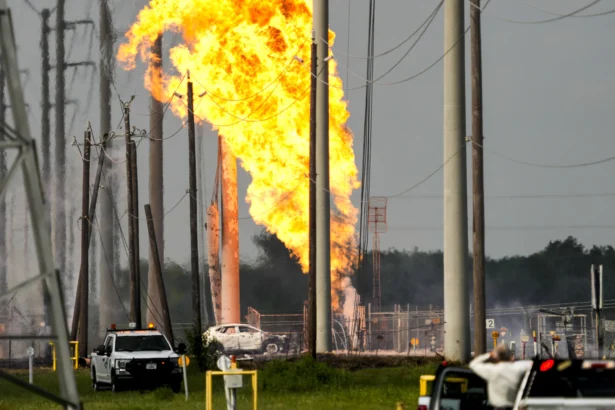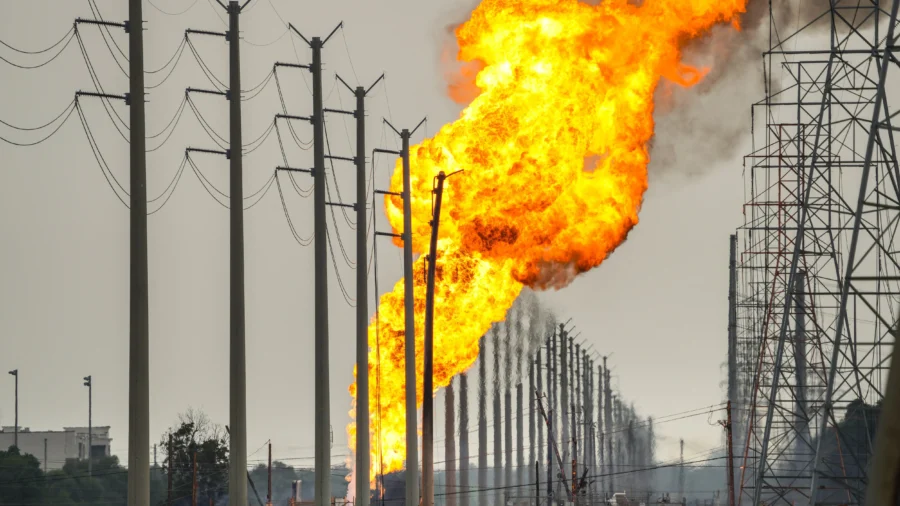DEER PARK, Texas—A pipeline fire that forced hundreds of people to flee their homes in the Houston suburbs burned for a third day Wednesday, with officials saying they don’t expect it to be extinguished until sometime Thursday evening.
Officials said residents who had to evacuate would be allowed to return to their homes starting Wednesday evening.
Authorities have offered few details about what prompted the driver of an SUV to hit an aboveground valve on the pipeline on Monday, sparking the blaze.
Here are some things to know about the situation with the pipeline fire:
What Caused the Fire?
Officials say the underground pipeline, which runs under high-voltage power lines in a grassy corridor between a Walmart and a residential neighborhood in Deer Park, was damaged when the SUV driver left the store’s parking lot, entered the wide grassy area and went through a fence surrounding the valve equipment.
Authorities have offered few details on what caused the vehicle to hit the pipeline valve, the identity of the driver or what happened to them. The pipeline company on Wednesday called it an accident. Deer Park officials said preliminary investigations by police and FBI agents found no evidence of a terrorist attack.
Deer Park police won’t be able to reach the burned-out vehicle until the flame has been extinguished. Once the area is safe, the department will be able to continue its investigation and confirm specifics, city spokesperson Kaitlyn Bluejacket said in an email Wednesday.
The valve equipment appears to have been protected by a chain-link fence topped with barbed wire. The pipeline’s operator has not responded to questions about any other safety protections that were in place.
Who is Responsible for the Pipeline?
Energy Transfer is the Dallas-based owner of the pipeline, a 20-inch-wide (50-centemeter-wide) conduit that runs for miles through the Houston area.
It carries natural gas liquids through the suburbs of Deer Park and La Porte, both of which are southeast of Houston. Energy Transfer said the fire had diminished overnight and was continuing to “safely burn itself out” on Wednesday.
Energy Transfer also built the Dakota Access Pipeline, which has been at the center of protests and legal battles.

What’s Being Done to Extinguish the Fire?
Energy Transfer said its crews were working Wednesday to install specialized isolation equipment on both sides of the damaged section that will help extinguish the fire.
Once the equipment is installed, which could take several hours of welding, the isolated section of the pipeline will be purged with nitrogen, which will extinguish the fire, company and local officials said. After that, damaged components can be repaired.
“The safest way to manage this process is to let the products burn off,” Energy Transfer said.
Late Wednesday afternoon, Deer Park officials said repair work on the pipeline to help speed up the process to put out the fire wasn’t expected to be completed until 6 p.m. on Thursday. Once finished, the fire was anticipated to be extinguished within two to three hours.
How Have Residents Been Impacted?
Authorities evacuated nearly 1,000 homes at one point and ordered people in nearby schools to shelter in place. Officials said that starting at 6 p.m. on Wednesday, residents in Deer Park and La Porte who had to evacuate would be allowed to return to their homes. A portion of a highway near the pipeline would remain closed, officials said.
Hundreds of customers lost power. Officials said Wednesday afternoon that only two customers remained without electricity in the Deer Park and La Porte area. Repairs to all of the power distribution lines affected by the fire had been completed.
Deer Park’s statement said Energy Transfer was “prioritizing the safety of the community and environment as it implements its emergency response plan.”
“We appreciate the patience and understanding of all residents during this ongoing situation,” Deer Park officials said.
By late Tuesday, about 400 evacuees remained, and some expressed frustration over being forced to quickly flee and not being given any timeline for when they will be able to return.
“We literally walked out with the clothes on our backs, the pets, and just left the neighborhood with no idea where we were going,” said Kristina Reff, who lives near the fire. “That was frustrating.”
What About Pollution From the Fire?
Energy Transfer and Harris County officials have said that air quality monitoring shows no immediate risk to individuals, despite the huge tower of billowing flame that shot hundreds of feet into the air, creating thick black smoke that hovered over the area.
Houston is the nation’s petrochemical heartland and is home to a cluster of refineries and plants and thousands of miles of pipelines. Explosions and fires are a familiar sight, and some have been deadly, raising recurring questions about industry efforts to protect the public and the environment.

